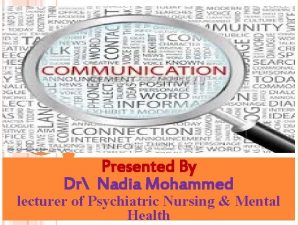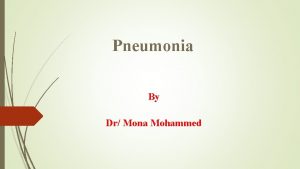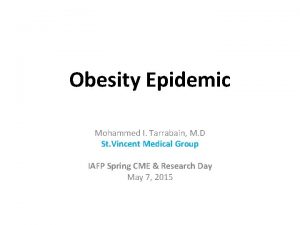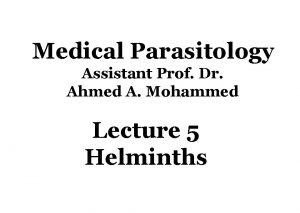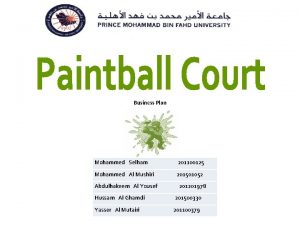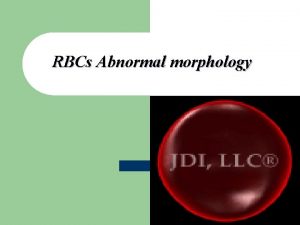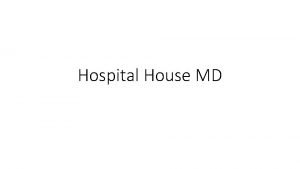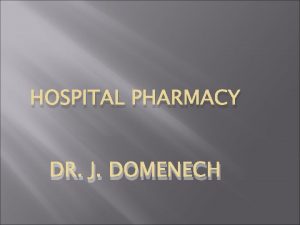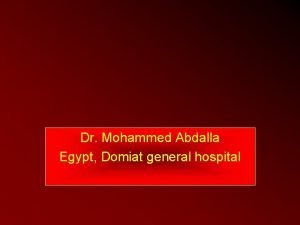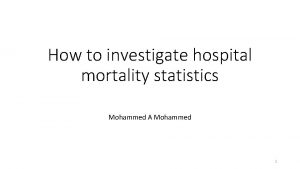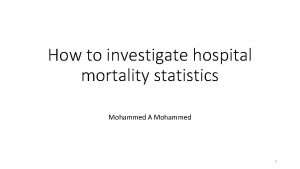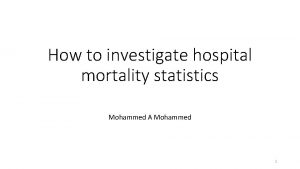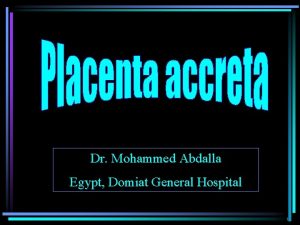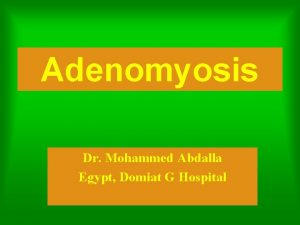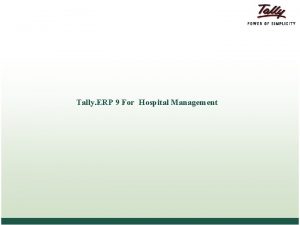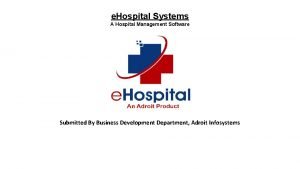Hospital Management AHEER MOHAMMED Hospital Hospital is a
























- Slides: 24

Hospital Management AHEER MOHAMMED

Hospital • Hospital is a place for the diagnosis and treatment of human ills and restoration of health and well-beings of those temporarily deprived of these. Professionally & technically skilled people apply their knowledge and skill with the help of complicated equipment and appliances - to provide quality care for the patient.

Functions of Hospital • 1. Patient care: Primary function (curative function) refers to any type of care given to patients by the health team members, e. g. Physicians; Nurses, Physical Therapists, Dietitians, etc. It also. includes health teaching to patients. • 2. Health Personnel Education: Secondary function (Educational function). Refers to the education of professional and technical personnel who provide health services, e. g. Physicians, Nurses, Dentists, Therapists, Technicians, etc.

• 3. Health Promotion: Secondary function (Preventive functioning emerging function for the hospital is that of a community health canter taking an active role to improve the health of the population it serves. Hospitals as major community health centers, can sponsor programs of environmental and occupational health, home care services, etc. • 4. Health Related Research: Secondary function (Research -function) Research that focuses on the improvement of health and/or prevention of disease.

Classifications of Hospitals are classified as follow: 1. The type of service There are two groups of hospitals: general and special. A. - General hospitals: -They care for patients with various- disease conditions for both sexes to all ages, medical, surgical, pediatrics, obstetrics, eye and ear hospital etc. General hospitals may contain specialized units staffed by specialized personnel, Renal Unit, Intensive Care Unit, Coronary Care Unit, Plastic Surgery Unit and Burn Unit. There may be specialization at Unit level, Neurological, Urological, Orthopedic Units, etc. • B. Special hospitals: They limit their service to a particular condition, orthopedics, maternity, pediatrics, geriatrics, etc. • •

Classifications of Hospitals • 2. Administration, ownership, control or financial income: • A. Governmental or public hospital: They are owned, administered and controlled by the government. They provide free care for patients. They may offer private accommodation for fee paying patients. • The governmental hospitals are owned by: �The Ministry of Health. �The University or �Others. • B: Non-governmental or private �Proprietary. Privately owned or controlled by an individual or group of Physicians or citizens or by private organization (profit-making). �Voluntary: Owned and operated by nonprofit organizations i. e. mosque or church A authorities

• C: Length of stay �Short-term or short-stay hospitals: These are hospitals where over 90% of all patients admitted stay less than 30 days. • Long-term or long-stay hospitals: These are hospitals where over 90% of all patients admitted stay 30 days or more, i. e. mental hospital. • D: Type of Medical Staff • Closed-staff hospital: Physicians are held responsible for all medical activities in the hospital including the diagnosis and treatment of patient fee paying and emergency. • Open-staff hospital: This type of hospital permits other physicians in the community to admit and treat patients to the hospital' and treat them.

• E: Size or bed capacity: • Small hospital 100 beds or less. Medium size hospital 300 beds or less. Large hospital 300 -1000 beds 100 -

Hospital Departments • A: Professional Health Service Departments • 1. Medical Department • The medical department has within it the various clinical services. They are: medicine, surgery, gynecology, obstetrics, pediatrics, eye, ENT, dental, orthopedics, neurology, cardiology, psychiatry, skin, - plastic surgery, nuclear medicine, etc. Medical Director is a Doctor who has control over all the medical department.

• 2. Nursing Department • The nursing department consists of nursing service and nursing education. The primary purpose of the nursing service is to provide comprehensive, safe, effective and well organized nursing care through the personnel of the department. The primary purpose of nursing education is to raise the standard of nursing service by providing in service education to nursing service personnel in the hospital.

• 3. Paramedical Departments: They include: • 1: Laboratory • a. Pathology department: The pathology department is one of the largest departments and has the responsibility for making tests and studies on blood, sputum, feces, body fluids and tissues. • b. Bacteriology department: This laboratory is concerned with studies about the bacteria and their toxins. • c. Biochemistry: this is considered with the chemistry of living organisms and of vital processes. • d. Hematology laboratory: It is responsible for making hemoglobin determinations, coagulation time studies, red and white cell counts and special blood pathology studies for anemia and. leukemia, etc.

• e. Parasitology laboratory: It studies the presence of parasites, the cyst and ovas of the parasites that are found in the feces. • f. Serology laboratory: It does blood agglutination tests, Wassermann tests, V. D. g. Blood bank: It has the responsibility for collecting and processing all blood used in the hospital for transfusions. It makes. Studies of new born infants who may have hemolytic diseases, and does antibody studies on the prenatal patients. • h. Histopathology laboratory: It prepares tissues for gross and microscopic studies.

• II: Pharmacy Department �the pharmacy department has the responsibility for selecting, purchasing, compounding, storing and dispensing all drugs and medications for in- patients and out-patients. • The pharmacy should be under the supervision of registered pharmacist.

• III: Physical medicine and rehabilitation Department �this department treats patients who have functional disabilities resulting from disease conditions or injuries. �it has several specialties such as: Physical therapy, occupational therapy, speech therapy and vocational training. • IV: Radiology Department �this department functions under the control of radiologist and qualified technical staff. �It has the following diagnostic and therapeutic services for in-patients and outpatients. a. Radiographic examination and their interactions. b. XRay, Radium, Radio Active Cobalt and other Radio Active therapy. c. Radio Active Isotopes Tracer. d. Radio Active Isotopes Therapy.

• 5: Dietary Department (Catering) in most hospital, this department is under the direction of a trained dietitian. The department is charged with: • 1. Ordering and preparation of food. • 2. Tray service. • 3. Diet teaching. The dietician is a member of the health team and works closely with nursing service personnel in meeting the patient's nutritional needs and in teaching. He/she is responsible for the ordering of supplies and the supervision of all staff engaged in the preparation and delivery of food.

• A periodic complete physical examination including X-Ray of chest, analysis of stool and urine and should be considered in order : • 1. to detect silent carriers &take appropriate action. • 2. Daily inspection of personal appearance and hygiene also are important.

• 6. Outpatient department This is a combination of several departments. It is a miniature of the hospital except that the patients are ambulatory. Specialities provide services. Individual may attend this department for the purpose of receiving treatment, or to enable a physician to assess their progress following discharge from hospital.

• 7. Accident & Emergency Department People who are classified as " emergency admission" are admitted to this department to receive life-saving services immediately needed after thorough examination by the responsible physician. • 8. Operating Theatre ( OT) It is a room in a hospital equipped for the performance of surgical operations; "great care should be taken to keep the operating rooms aseptic. • An operating room (OR), also called surgery center, is the unit of a hospital where surgical procedures are performed.

• Non –Professional Health Service Departments • 1. Admitting Department • This department has the responsibility for admitting the patient to the hospital. It should maintain good public relations. The patient, family and friends must be treated with utmost respect, courtesy and tact.

• 2. Personnel Department • The functions of this department are as follow: • a. Recruitment of personnel. b. Interviewing. c. Promotion and transfer. d. Termination of employment. e. In-Service training. f. Safety. g. Health programs. h. Recreation. i. Remuneration and Incentives. • 3. Purchasing Department • This department has the responsibility for purchasing all supplies and equipment for the hospital.

• 4. Medical Records • This is one of the important departments in the hospital. The patient's records ( charts, X-Ray, etc. . ) are valuable not only to the patient but also to the Doctor and to medical and nursing education and research. • 5. House Keeping Department ( Domestic Services) • The main function of this department is to keep the hospital clean. It plays an important role in hospital hygiene and infection control.

• 6. Laundry Department • Laundry service is responsible for providing an adequate, clean and constant supply of linen to all users. The basic tasks include: sorting, washing, extracting, drying, ironing, folding, mending and delivery. • The functions of the laundry services • 1. Collecting soiled linen from various places. • 2. Sorting the linen and processing them • 3. Inspecting and repairing or replacing damaged materials. • 4. Distributing clean linen to the respective user departments. • 5. Maintaining different types of registers.

• 7. Mechanical Department • The mechanical department looks after electricity, water, supply, heat, air conditioning, etc…. • 8. Maintenance Department • Maintenance department keeps the hospital in good condition. Enters, painters, gardeners, etc. are included in the personnel of this department.

• 10. Central Sterile Supply Department (C. S. S. D): , . In modern hospitals, the trend is toward centralization of preparation and sterilization of supplies and equipment.
 Rahaf mohammed video
Rahaf mohammed video Dr nadia mohammed
Dr nadia mohammed Mohammed mona md
Mohammed mona md Dr samah mohammed
Dr samah mohammed Dr samah mohammed
Dr samah mohammed Dr mohammed tarrabain
Dr mohammed tarrabain Mohammed houssein kamali
Mohammed houssein kamali Dr mohammed ahmed
Dr mohammed ahmed Coco turkie
Coco turkie Dr mohammed ahmed
Dr mohammed ahmed Mohammed yusuf (boko haram)
Mohammed yusuf (boko haram) Dr mohammed shaker
Dr mohammed shaker Dr aleem mohammed
Dr aleem mohammed Dr tarrabain
Dr tarrabain Epcardium
Epcardium Dr mohammed shaker
Dr mohammed shaker Mohammed aledhari
Mohammed aledhari Dr samah mohammed
Dr samah mohammed Mohammed airaj
Mohammed airaj Ahmed mohammed security
Ahmed mohammed security Dr mohammed obaidullah
Dr mohammed obaidullah Auditory pathway ecolima
Auditory pathway ecolima Diffset
Diffset Mohammed
Mohammed Httpfac
Httpfac

